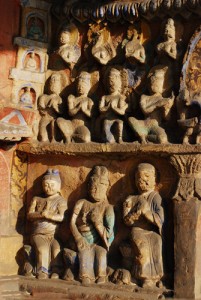Yungang Grottoes From Da Tong
 Yungang Grottoes in December 2001 was selected "World Heritage List", it is also the world-famous art treasures of stone. In 1961 the State Council promulgated a national key cultural relics protection units in 2001, was listed as World Heritage. May 8, 2007, Datong Yungang Grottoes formally approved by the China National Tourism Administration for the state 5A-class tourist attractions. All walks of life has become an important place for sightseeing, but also admiration and yearning for international friends to visit.
Yungang Grottoes in December 2001 was selected "World Heritage List", it is also the world-famous art treasures of stone. In 1961 the State Council promulgated a national key cultural relics protection units in 2001, was listed as World Heritage. May 8, 2007, Datong Yungang Grottoes formally approved by the China National Tourism Administration for the state 5A-class tourist attractions. All walks of life has become an important place for sightseeing, but also admiration and yearning for international friends to visit.
The statues, flying, sponsors, dependent on the person's face and clothing, have left the ancient wisdom and hard working people. The statues carved with Leji like, but also clearly reveals the exotic colors. In China, based on the traditional art of carving, drawing, fusion of Indian and Persian art of Gandhara art of the essence, this is the ancient wisdom of the people's creative work, is their friendly exchanges with other countries to witness history. Yungang Grottoes dating back over 1500 years of history, was founded in 460 AD by the Buddhist monk Tan Yao was dug for granted. Yungang Grottoes existing, in 1961 the State Council announced the first batch of national key cultural relics protection units. The grotto is divided into eastern, central and west parts of caves inside the shrines, like cellular clouds, large, medium and small cave density delivered to halfway embedded in Yungang. East of the caves in order to build more tower-based, it is also known as the tower hole; central points before and after each two-bedroom cave, the main Buddhist center, wall and roof covered with relief; small cave in the western caves carved small niches and complement To most, built slightly later era, most of the works after the Northern Wei capital Luoyang. The whole spirit caves grand, solemn appearance, fine workmanship, a prominent theme. Grotto sculpture religious characters look different. The carving technique, the inheritance and development of China's Qin and Han Dynasty art tradition, but also absorbed the art of Gandhara useful elements to create a unique artistic style Yungang, the study of sculpture, architecture, music, religion is extremely valuable information.



